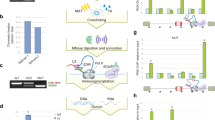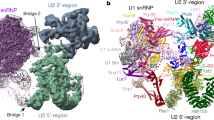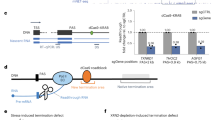Abstract
We investigated whether a continuous transcript is necessary for co-transcriptional pre-mRNA processing. Cutting an intron with the fast-cleaving hepatitis δ ribozyme, but not the slower hammerhead, inhibited splicing. Therefore, exon tethering to RNA polymerase II (Pol II) cannot rescue splicing of a transcript severed by a ribozyme that cleaves rapidly relative to the rate of splicing. Ribozyme cutting also released cap-binding complex (CBC) from the gene, suggesting that exon 1 is not tethered. Unexpectedly, cutting within exons inhibited splicing of distal introns, where exon definition is not affected, probably owing to disruption of the interactions with the CBC and the Pol II C-terminal domain that facilitate splicing. Ribozyme cutting within the mRNA also inhibited 3′ processing and transcription termination. We propose that damaging the nascent transcript aborts pre-mRNA processing and that this mechanism may help to prevent association of processing factors with Pol II that is not productively engaged in transcription.
This is a preview of subscription content, access via your institution
Access options
Subscribe to this journal
Receive 12 print issues and online access
$189.00 per year
only $15.75 per issue
Buy this article
- Purchase on Springer Link
- Instant access to full article PDF
Prices may be subject to local taxes which are calculated during checkout






Similar content being viewed by others
References
Phatnani, H.P. & Greenleaf, A.L. Phosphorylation and functions of the RNA polymerase II CTD. Genes Dev. 20, 2922–2936 (2006).
Bentley, D.L. Rules of engagement: co-transcriptional recruitment of pre-mRNA processing factors. Curr. Opin. Cell Biol. 17, 251–256 (2005).
Hirose, Y. & Manley, J.L. RNA polymerase II and the integration of nuclear events. Genes Dev. 14, 1415–1429 (2000).
Ryman, K., Fong, N., Bratt, E., Bentley, D.L. & Ohman, M. The C-terminal domain of RNA Pol II helps ensure that editing precedes splicing of the GluR-B transcript. RNA 13, 1071–1078 (2007).
Kaneko, S. & Manley, J.L. The mammalian RNA polymerase II C-terminal domain interacts with RNA to suppress transcription-coupled 3′ end formation. Mol. Cell 20, 91–103 (2005).
Mortillaro, M.J. et al. A hyperphosphorylated form of the large subunit of RNA polymerase II is associated with splicing complexes and the nuclear matrix. Proc. Natl. Acad. Sci. USA 93, 8253–8257 (1996).
Das, R. et al. SR proteins function in coupling RNAP II transcription to pre-mRNA splicing. Mol. Cell 26, 867–881 (2007).
Ujvári, A. & Luse, D.S. Newly initiated RNA encounters a factor involved in splicing immediately upon emerging from within RNA polymerase II. J. Biol. Chem. 279, 49773–49779 (2004).
Keen, N.J., Churcher, M.J. & Karn, J. Transfer of Tat and release of TAR RNA during the activation of the human immunodeficiency virus type-1 transcription elongation complex. EMBO J. 16, 5260–5272 (1997).
Fong, N. & Bentley, D. Capping, splicing and 3′ processing are independently stimulated by RNA polymerase II: different functions for different segments of the CTD. Genes Dev. 15, 1783–1795 (2001).
Houseley, J. & Tollervey, D. The nuclear RNA surveillance machinery: The link between ncRNAs and genome structure in budding yeast? Biochim. Biophys. Acta 1779, 236–246 (2008).
Wong, C.M., Qiu, H., Hu, C., Dong, J. & Hinnebusch, A.G. Yeast cap binding complex impedes recruitment of cleavage factor IA to weak termination sites. Mol. Cell. Biol. 27, 6520–6531 (2007).
Lejeune, F., Ishigaki, Y., Li, X. & Maquat, L.E. The exon junction complex is detected on CBP80-bound but not eIF4E-bound mRNA in mammalian cells: dynamics of mRNP remodeling. EMBO J. 21, 3536–3545 (2002).
Listerman, I., Sapra, A.K. & Neugebauer, K.M. Cotranscriptional coupling of splicing factor recruitment and precursor messenger RNA splicing in mammalian cells. Nat. Struct. Mol. Biol. 13, 815–822 (2006).
Izaurralde, E. et al. A nuclear cap binding protein complex involved in pre-mRNA splicing. Cell 78, 657–668 (1994).
Lewis, J.D., Izaurralde, E., Jarmolowski, A., Mcguigan, C. & Mattaj, I.W. A nuclear cap-binding complex facilitates association of U1-SNRNP with the cap-proximal 5′ splice-site. Genes Dev. 10, 1683–1698 (1996).
Görnemann, J., Kotovic, K.M., Hujer, K. & Neugebauer, K.M. Cotranscriptional spliceosome assembly occurs in a stepwise fashion and requires the cap binding complex. Mol. Cell 19, 53–63 (2005).
Flaherty, S.M., Fortes, P., Izaurralde, E., Mattaj, I.W. & Gilmartin, G.M. Participation of the nuclear cap binding complex in pre-mRNA 3′ processing. Proc. Natl. Acad. Sci. USA 94, 11893–11898 (1997).
Adamson, T.E., Shutt, D.C. & Price, D.H. Functional coupling of cleavage and polyadenylation with transcription of mRNA. J. Biol. Chem. 280, 32262–32271 (2005).
Rigo, F., Kazerouninia, A., Nag, A. & Martinson, H.G. The RNA tether from the poly(A) signal to the polymerase mediates coupling of transcription to cleavage and polyadenylation. Mol. Cell 20, 733–745 (2005).
Dye, M.J., Gromak, N. & Proudfoot, N.J. Exon tethering in transcription by RNA polymerase II. Mol. Cell 21, 849–859 (2006).
Lacadie, S.A., Tardiff, D.F., Kadener, S. & Rosbash, M. In vivo commitment to yeast cotranscriptional splicing is sensitive to transcription elongation mutants. Genes Dev. 20, 2055–2066 (2006).
Kim, Y.K. & Kim, V.N. Processing of intronic microRNAs. EMBO J. 26, 775–783 (2007).
Morlando, M. et al. Primary microRNA transcripts are processed co-transcriptionally. Nat. Struct. Mol. Biol. 15, 902–909 (2008).
Anderson, K. & Moore, M.J. Bimolecular exon ligation by the human spliceosome. Science 276, 1712–1716 (1997).
West, S., Proudfoot, N.J. & Dye, M.J. Molecular dissection of mammalian RNA polymerase II transcriptional termination. Mol. Cell 29, 600–610 (2008).
Berget, S.M. Exon recognition in vertebrate splicing. J. Biol. Chem. 270, 2411–2414 (1995).
O'Mullane, L. & Eperon, I.C. The pre-mRNA 5′ cap determines whether U6 small nuclear RNA succeeds U1 small nuclear ribonucleoprotein particle at 5′ splice sites. Mol. Cell. Biol. 18, 7510–7520 (1998).
Wu, J.Y. & Maniatis, T. Specific interactions between proteins implicated in splice site selection and regulated alternative splicing. Cell 75, 1061–1070 (1993).
Lam, B.J. & Hertel, K.J. A general role for splicing enhancers in exon definition. RNA 8, 1233–1241 (2002).
Kyburz, A., Friedlein, A., Langen, H. & Keller, W. Direct interactions between subunits of CPSF and the U2 snRNP contribute to the coupling of pre-mRNA 3′ end processing and splicing. Mol. Cell 23, 195–205 (2006).
Millevoi, S. et al. An interaction between U2AF 65 and CF Im links the splicing and 3′ end processing machineries. EMBO J. 25, 4854–4864 (2006).
Rigo, F. & Martinson, H.G. Functional coupling of last-intron splicing and 3′-end processing to transcription in vitro: the poly(A) signal couples to splicing before committing to cleavage. Mol. Cell. Biol. 28, 849–862 (2008).
Bird, G., Fong, N., Gatlin, J.C., Farabaugh, S. & Bentley, D.L. Ribozyme cleavage reveals connections between mRNA release from the site of transcription and pre-mRNA processing. Mol. Cell 20, 747–758 (2005).
Rosonina, E., Kaneko, S. & Manley, J.L. Terminating the transcript: breaking up is hard to do. Genes Dev. 20, 1050–1056 (2006).
Huang, Y. & Carmichael, G.C. Role of polyadenylation in nucleocytoplasmic transport of mRNA. Mol. Cell. Biol. 16, 1534–1542 (1996).
Perrotta, A.T., Shih, I. & Been, M.D. Imidazole rescue of a cytosine mutation in a self-cleaving ribozyme. Science 286, 123–126 (1999).
Stage-Zimmermann, T.K. & Uhlenbeck, O.C. Hammerhead ribozyme kinetics. RNA 4, 875–889 (1998).
Zeng, Y. & Cullen, B.R. Sequence requirements for micro RNA processing and function in human cells. RNA 9, 112–123 (2003).
Pawlicki, J.M. & Steitz, J.A. Primary microRNA transcript retention at sites of transcription leads to enhanced microRNA production. J. Cell Biol. 182, 61–76 (2008).
Connelly, S. & Manley, J.L. A functional mRNA polyadenylation signal is required for transcription termination by RNA polymerase II. Genes Dev. 2, 440–452 (1988).
Dye, M.J. & Proudfoot, N.J. Multiple transcript cleavage precedes polymerase release in termination by RNA polymerase II. Cell 105, 669–681 (2001).
de Almeida, S.F. & Carmo-Fonseca, M. The CTD role in cotranscriptional RNA processing and surveillance. FEBS Lett. 582, 1971–1976 (2008).
Glover-Cutter, K., Kim, S., Espinosa, J. & Bentley, D.L. RNA polymerase II pauses and associates with pre-mRNA processing factors at both ends of genes. Nat. Struct. Mol. Biol. 15, 71–78 (2008).
Bird, G., Zorio, D.A. & Bentley, D.L. RNA polymerase II carboxy-terminal domain phosphorylation is required for cotranscriptional pre-mRNA splicing and 3′-end formation. Mol. Cell. Biol. 24, 8963–8969 (2004).
Samarsky, D.A. et al. A small nucleolar RNA:ribozyme hybrid cleaves a nucleolar RNA target in vivo with near-perfect efficiency. Proc. Natl. Acad. Sci. USA 96, 6609–6614 (1999).
Khvorova, A., Lescoute, A., Westhof, E. & Jayasena, S.D. Sequence elements outside the hammerhead ribozyme catalytic core enable intracellular activity. Nat. Struct. Biol. 10, 708–712 (2003).
Acknowledgements
Supported by the US National Institutes of Health (NIH) grant GM58613 to D.B. We thank T. Blumenthal, R. Davis, R. Ferguson, J. Underwood, J. Manley, K. Ryman, B. Cullen and S. Chavez for helpful suggestions, E. Izaurralde (Universität Tubingen) for anti-CBP80, B. Cullen (Duke University) for miR21 and miR30 plasmids, J. Lykke-Andersen (University of Colorado) for Upf1 and PM-Scl75 plasmids, and the University of Colorado Health Sciences Center Cancer Center sequencing facility.
Author information
Authors and Affiliations
Contributions
N.F., M.O. and D.L.B. designed experiments; N.F. performed the experiments, except the RNA editing analysis in Figure 4c, which was done by M.O.; D.L.B. wrote the manuscript.
Corresponding author
Supplementary information
Supplementary Text and Figures
Supplementary Figures 1–5 and Supplementary Tables 1–3 (PDF 1986 kb)
Rights and permissions
About this article
Cite this article
Fong, N., Öhman, M. & Bentley, D. Fast ribozyme cleavage releases transcripts from RNA polymerase II and aborts co-transcriptional pre-mRNA processing. Nat Struct Mol Biol 16, 916–922 (2009). https://doi.org/10.1038/nsmb.1652
Received:
Accepted:
Published:
Issue Date:
DOI: https://doi.org/10.1038/nsmb.1652
This article is cited by
-
Herpes simplex virus blocks host transcription termination via the bimodal activities of ICP27
Nature Communications (2020)
-
DBIRD complex integrates alternative mRNA splicing with RNA polymerase II transcript elongation
Nature (2012)
-
Biological Significance of RNA Editing in Cells
Molecular Biotechnology (2012)
-
Intronic hammerhead ribozymes are ultraconserved in the human genome
EMBO reports (2010)
-
Dangerous play—splitting the message may leave you empty handed
Nature Structural & Molecular Biology (2009)



